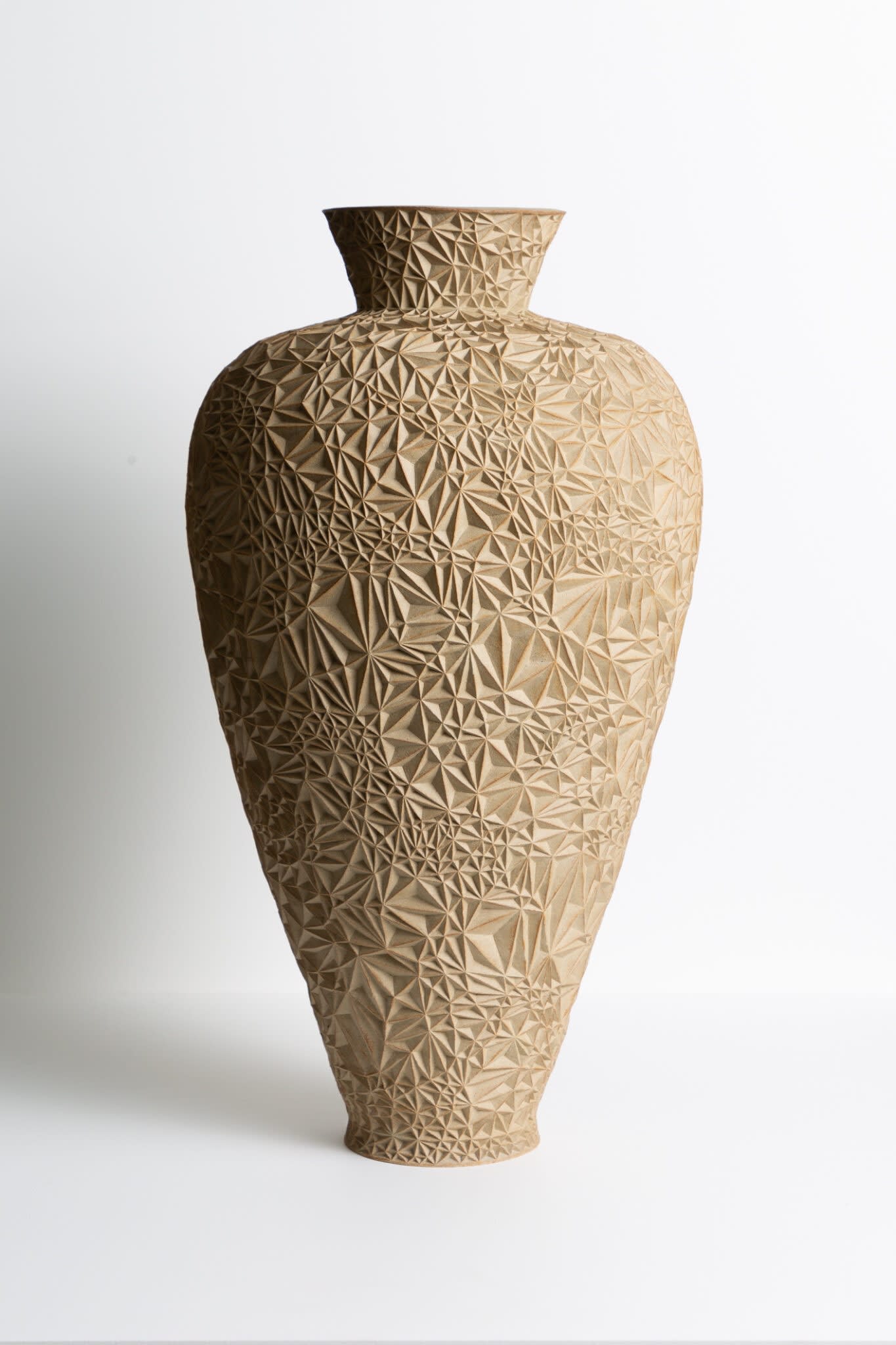When we first spotted Leah Jensen’s work back in 2015 following her participation in the Crafts Council’s Hot House Programme, we found ourselves completely spell-bound. The artist’s work has grown from strength to strength since then and was recently seen in The Economist’s 1843 magazine in their Objects of Desire feature. We are currently showcasing two of Leah’s pieces at our stand at Focus/20 at the Design Centre Chelsea Harbour. Here, we dig deeper into exactly what inspires Leah’s work and how these intricately carved vessels are made.
-

The Healing of Justinian by Leah Jensen
Photographed by Alexander Kent for Economist 1843 2020At first glance of Leah Jensen's work, you can not help but delight in the sheer beauty of each form, your appreciation heightened by the exactitude of the artist's craftsmanship. When you then discover that the origin of the carvings on each of Leah's ceramic vessels comes from her love of Renaissance paintings you realise that the work goes beyond elaborate technique. It is rich and laden with meaning and despite being clean-cut and contemporary in its form, its tendrils stretch back in time, hundreds of years into the past. As curators of both 2D and 3D work, we are thrilled to be working with an artist who is so incredibly skilled and whose creative output fuels both of our passions.
Can you tell us about your making process, Leah?
"I had been developing the ability to carve into clay in a distinct geometric style, I was enjoying the increasing complexity and precision, but I still felt like something was missing: I needed a deeper narrative to my work.
"Around this time I happened to read an article about the relationship between mathematics and art during the Renaissance period. It referred to a calculation called the Golden Ratio, used by artists to locate aesthetically pleasing areas in which subjects could be placed to distribute weight in their paintings. The article revealed the artists' preliminary drawings and calculations, and I was fascinated. I can't say how the idea for the pattern-mapping developed from there; It just seemed like the most obvious step forward for me.

Exploring the Golden Ratio, Leah Jensen meticulously plans the hand-carved designs of each of her vessels, an approach inspired by techniques used by painters during the Renaissance period.
Work in progress The Healing of Justinian by Leah Jensen
Photographed by Alexander Kent for Economist 1843 2020"Today, the sequence I follow flows like this: Once I have my hand-built vessel at hand, I apply images of a painting onto the unfired clay surface. I then use pins to pick out points within that painting which I feel are key to the layout-they might be facial features, negative space created by limbs or the corners of buildings. Once the paper and pins are removed, I am left with a network of pinholes, which I then join to create my carvings. The irregular intervals in each piece pose a complex challenge and test my carving ability. At the same time, these points are dictated to me in a very sporadic way, which I don't feel I would have been able to achieve as effectively by any other means.
"Carving each vessel by hand is a very slow and mediative process that allows space for reflection. Once the vessel is complete the narrative is hidden, just as the structure of the painting before it."
The starting point of Leah Jensen’s , The Healing of Justinian, inspired by the Renaissance Painting Saint Cosmas and Saint Damian, by Fra Angelico, 1438-40, Tempera on wood, 37 x 45 cm, Museo di San Marco, Florence
Leah, you challenge digital fabrication in some way, by creating complex forms that would appear to be 3-D printed, but are handmade instead. When did this contradictory relationship with digital forms of making begin?
"This is not something I had put any thought into until I showed my work in public for the very first time; people asked me about 3D printing, about the software and machinery I was using. Initially, I was shocked, and a little bit disheartened. I even considered altering the appearance of my work to show that it was handmade.
"Ultimately, I decided to embrace the fact that the vessels looked machine-made, as well as play around with this idea. That is when I began using the phrase 'anti-digital,' as a way to immediately draw people's attention, and make them question what they are looking at.
"The endurance of making each piece is critical to me; each piece usually takes between 120-180 hours to carve-the same action repeated over and over again. So, despite being fascinated with 3D printing, as of now, I find little enjoyment in using digital techniques in my work.
"There is something too important and therapeutic for me about making things with my hands that I couldn't imagine giving up."
Leah’s latest stoneware vessel derives from an early Renaissance painting by Giotto di Bondone called St. Francis Preaching to the Birds 1297-1299 270cm x 200cm located in the Basilica of Saint Francis of Assisi, Assisi, Italy

Planning the pattern for St Francis Preaching to the Birds

Leah hand carves each piece which can take up as much as 150 hours of work

Saint Francis of Assisi Preaching to the Birds by Leah Jensen, H38.5cm x W22cm, Stoneware 2020 Photography by Robert Chadwick
To see Leah Jensen’s work, alongside the work of ceramic sculptors Akiko Hirai, Matthew Chambers, Ashraf Hanna, Nicholas Lees, Frances Priest, Ikuko Iwamoto and Sun Kim, at our stand at Design Centre Chelsea Harbour until this Friday, September 25th 2020 10am-6pm.
-
A time-lapse of the making of a previous creation by Leah Jensen inspired by the painting The Death of Lucretia by Sandro Botticelli
